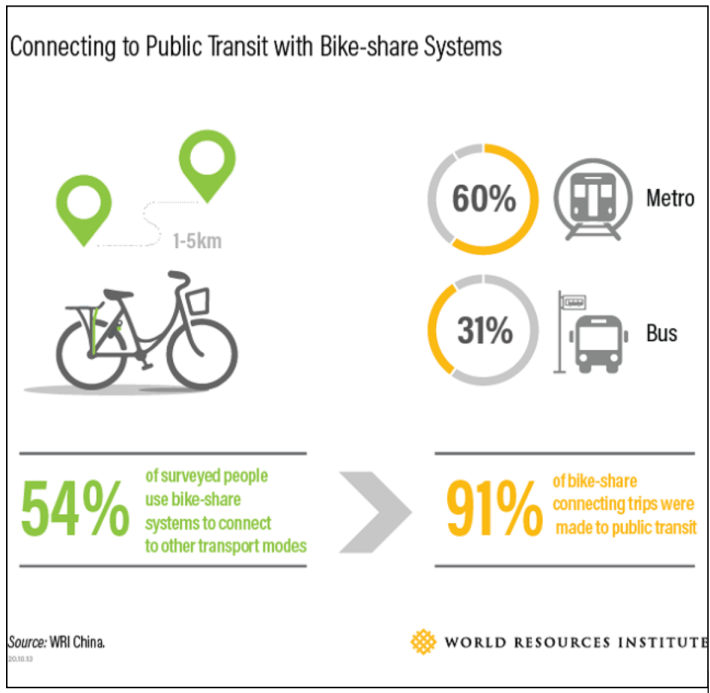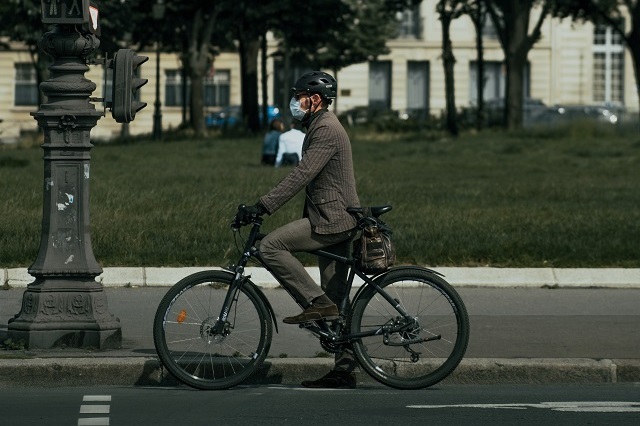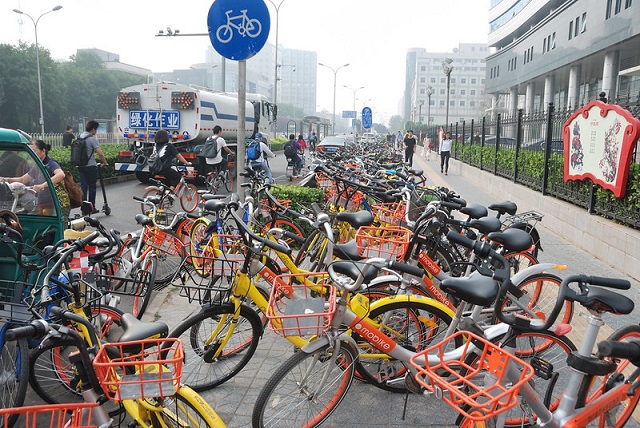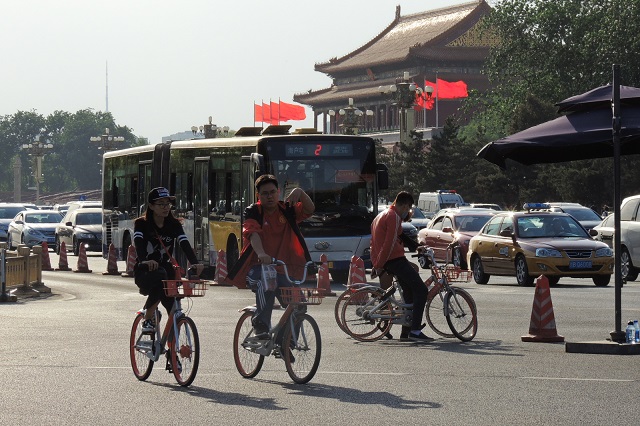City dwellers worldwide are shifting lifestyles as a result of the COVID-19 pandemic, especially in terms of transport. As cities begin to re-open, urban planners and designers are rethinking urban and transport infrastructure to adapt to a post-pandemic world. When considering options for resilient infrastructure, dockless bike-share systems – which were growing in popularity before the pandemic – have the potential to become a critical piece of the puzzle.
Hundreds of cities already have dockless bike-share systems in place, often serving as a means of transportation for the short distance to and from transit stations. China is largely responsible for the global boom in dockless sharing over the past five years. More than 360 Chinese cities now have dockless bike-share systems, with an average of 47 million trips each day.
A recently released WRI report, How Dockless Bike Sharing Changes Lives, investigated the comprehensive nationwide impact of dockless bike-share systems in 12 Chinese cities with relatively high bike-share usage and a thriving bike-share economy: Shanghai, Beijing, Guangzhou, Shenzhen, Chengdu, Wuhan, Hangzhou, Nanjing, Xi’an, Jinan, Xiamen and Lanzhou.
The study found that, with effective management and safe infrastructure, dockless bike-share systems can be an excellent last-mile urban mobility solution that enhances connectivity to public transit, reduces carbon emissions by replacing motorized trips, and improves public health by preventing thousands of premature deaths.
Dockless Bike Sharing Enhances Connectivity to Transit
In Chinese cities, about 82% to 86% of urban areas have access to public transport services within 500 meters. While this makes public transit a great option for most, it still leaves almost one-fifth of cities without proper transit options, especially considering that 500 meters is a significant distance to travel. As a result, the central concern in most cities is how to improve “first- and last-mile” connections to public transit and build fully integrated transport systems.

A survey of nearly 7,000 dockless bike-share users across the 12 cities in China found that 54% of users rode for convenient connections to other transport modes. The survey also found that dockless bikes are widely used in commuting. For those who used them to connect to other modes, 91% connected to public transit systems, including buses (31%) and metro (60%). Prior to using dockless bikes, 78% walked, 57% took a regular bus and 33% took motorized vehicles to connect to public transit.
Dockless Bike Sharing Reduces Motorized Trips
Cycling has great potential to replace motorized trips in cities, which can improve road safety, air pollution, climate emissions and more. When counting vehicle miles traveled, the study found that dockless bike sharing replaced about 13,800 km of previously motorized trips in total. Depending on the city, between 17% and 45% of total bike share miles traveled replaced motorized miles traveled. Among surveyed users, 11% switched from private cars, 14% from taxis or ride-hailing services and 6% from motorcycles. In total, bike sharing could reduce total CO2 emissions by 4.8 million tons annually in China.
Dockless Bike Sharing Generates Positive Health Impacts
The increased ridership of dockless bike systems in China not only changed travel behaviors, but is improving public health through increased physical activity.
Although cycling is not recommended for more than 30 minutes per day in areas with high levels of air pollution (PM2.5 level above 160µg/m3), one hour of cycling in areas with less pollution (PM2.5 level within 50-60µg/m3) can produce significant health benefits. By increasing fitness and reducing stress, cycling can reduce the chances of developing many health problems. These benefits add up to almost 60,000 fewer deaths annually among China’s 235 million dockless bike-share users.

Dockless Bike Sharing and COVID-19
Although this study took place prior to the COVID-19 pandemic, the findings are especially relevant now. During the pandemic, bicycles have become one of the few resilient and safe ways to move around for essential needs, as biking allows for greater social distancing than other means of public transportation.
From the end of January to the beginning of March, 2.3 million people in Wuhan used dockless bikes, accounting for more than half of all non-walking trips in the city at the time. Since the pandemic, people are also traveling farther on bikes. After re-opening, trips using dockless bike systems in Guangzhou and Beijing increased 60% and 150%, respectively.
Enhancing Fleet Management and Cycling Facilities
Based on the multiple benefits dockless bike sharing can generate, cities should encourage more people to use these systems for daily transport. However, China’s bike graveyards and early challenges with overrun sidewalks show that dockless bikes are only effective and beneficial to cities when properly managed.

Poorly managed fleets and unsafe cycling infrastructure can cluster and block public spaces, which raise challenges on regulatory and technical enablers. Cycling facilities are not improving fast enough to accommodate surging bike-share use in most Chinese cities. As a result, users generally perceive the service as unsafe, with only 7% of respondents reporting feeling safe while riding. In 2018, more than 20,000 bicyclists died on roads across China1. While it’s impossible to get an exact count, the widespread use of the systems could mean that up to two thirds of those fatalities happened on dockless bikes.
To better control and manage the dockless fleets, cities in China introduced innovative management measures and pilot projects to enhance the aesthetics of streetscapes. For example, cities are increasingly setting up performance-based evaluation systemsto renew and terminate permits for operators and adjust fleet sizes based on the quarterly performance.
Some cities set up parking design standards with geofence solutions. This can significantly enhance parking efficiency by informing users where to park via the service app and allowing more of the operator’s workforce to focus on fleet distribution.
Setting up clear rules for fleet management and implementing safer infrastructure are the keys to reaping the full benefits of dockless bikes. Although Chinese cities prioritized cycling over other transport modes in local transport planning and design standards over the past few years, not all infrastructure was put in place with a primary focus on safety. In addition to fleet management, dedicated cycling lanes and parking facilities, traffic calming measures and safer crossings for cyclists at intersections should be part of any plan to introduce more dockless bikes to cities.
Dockless Bike Sharing as a Future Mobility Solution
The pace of technology-driven innovation from the private sector in micromobility and other shared transportation services, like ride hailing, is rapidly reshaping and challenging urban mobility ecosystems.
As cities consider how to provide sustainable and safe transportation – during the COVID-19 pandemic and beyond – China’s experience at the vanguard of the dockless bike movement provides important lessons. The impacts and management of dockless bikes in Chinese cities show how they can bring a myriad of health, climate and economic benefits, reshaping urban mobility and giving people a more resilient, effective way to travel.
1: This figure was estimated based on two reports from the World Health Organization: one on road traffic deaths by country in 2016, and the other on a 2018 global road safety status report.
Hui Jiang is a Research Analyst at WRI China Ross Center for Sustainable Cities. Su Song is a Research Associate at WRI China Ross Center. Lu Lu is a Research Analyst for the Transport Program at WRI China Ross Center. This blog was originally published on WRI’s Insights and is republished here with permission.






